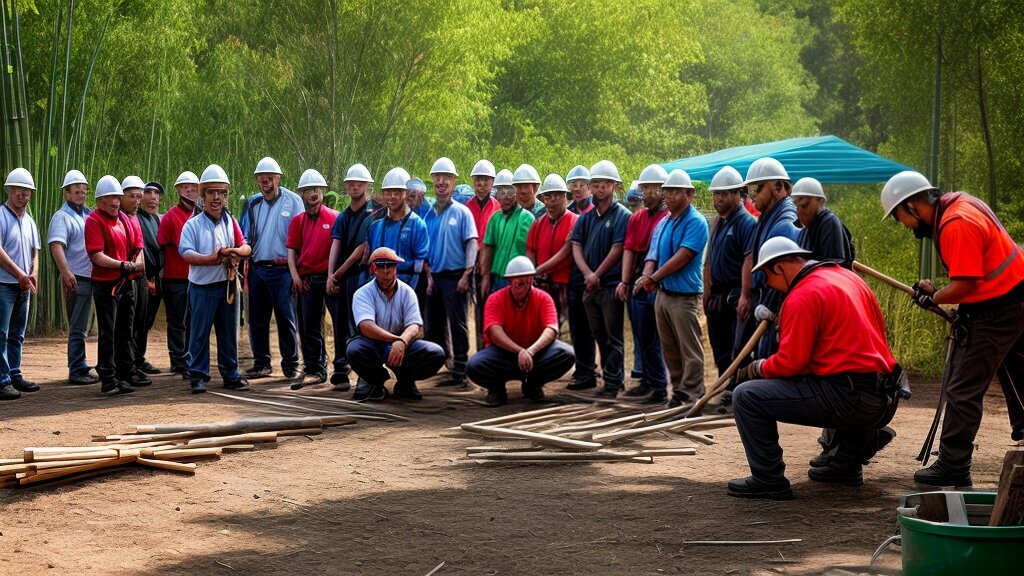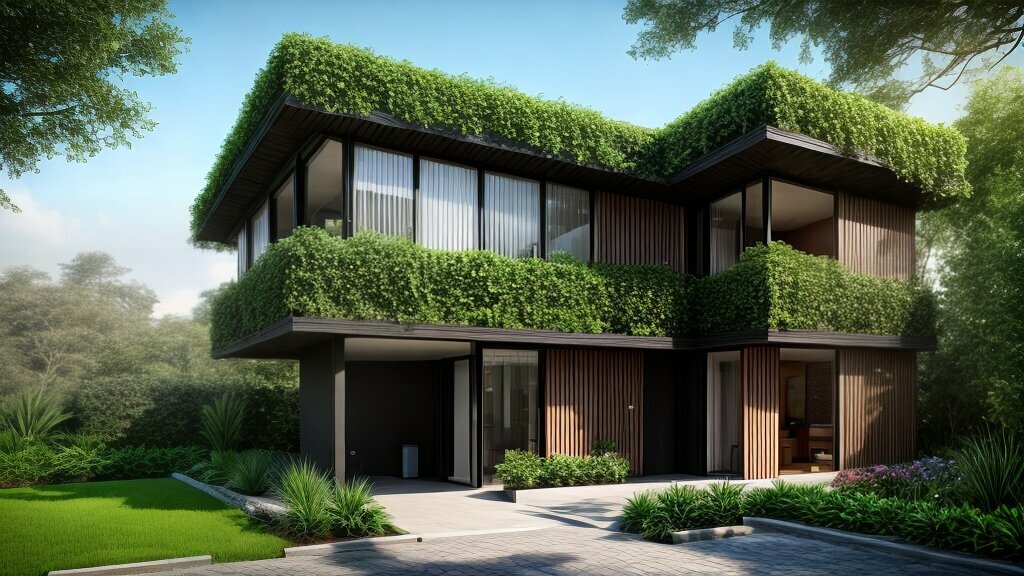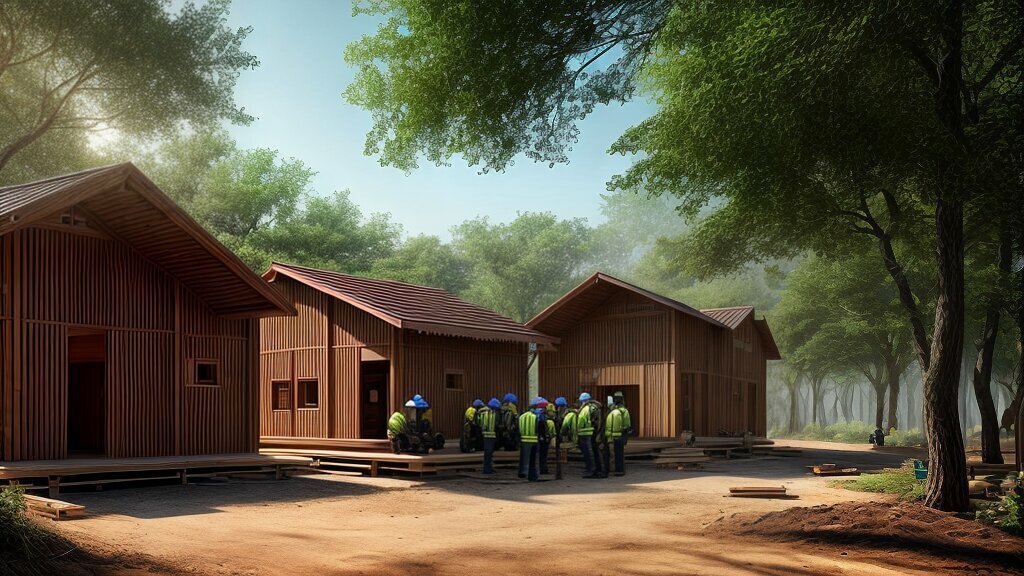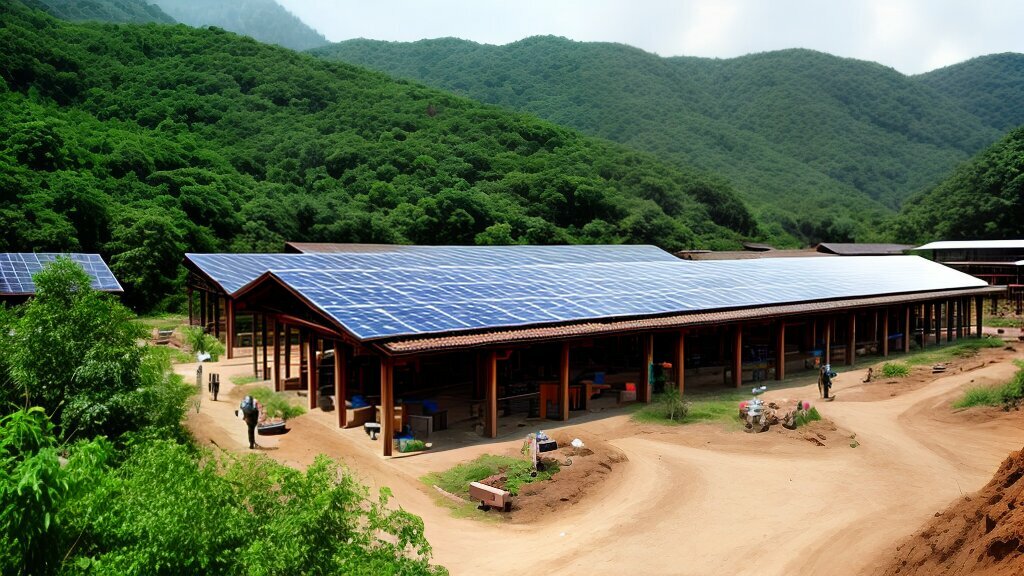Welcome to our article on Community-Driven Sustainable Construction! In today’s world, building sustainably has become increasingly important due to the impact of climate change and the depletion of natural resources. Sustainable construction practices not only benefit the environment but also provide social and economic benefits to local communities.
Community-Driven Sustainable Construction is a concept that places local communities at the forefront of construction projects. It empowers communities to take ownership of the building process, ensuring that projects are aligned with their needs and values. This approach fosters collaboration, innovation, and creativity, leading to sustainable development that supports both the environment and local communities.
Key Takeaways:
- Community-Driven Sustainable Construction empowers local communities in the construction process
- Sustainable building practices have positive environmental, social, and economic impacts
- Eco-friendly construction methods are crucial for creating a more sustainable built environment
In recent years, a growing movement towards community-driven sustainable construction has emerged, recognizing the importance of empowering local communities in the building process. The collaborative construction model has become a key approach in achieving this goal, placing a strong emphasis on community involvement in construction projects. By engaging local stakeholders, this model allows for a more tailored and context-specific application of sustainable construction methods, ensuring long-term environmental and social benefits.
One of the key benefits of the collaborative construction model is the promotion of sustainable construction methods. By involving the community in every stage of the construction process, from design to implementation and operation, a greater awareness and understanding of sustainable building practices can be achieved. This not only yields economic benefits, such as reduced energy and water usage, but also contributes to the preservation of local ecosystems and cultural heritage.

Moreover, the collaborative construction model fosters a sense of ownership and pride among community members, promoting social cohesion and strengthening community resilience. This approach is particularly relevant in vulnerable or marginalized communities, where community-driven sustainable construction can have a significant impact on improving livelihoods and well-being.
Examples of successful collaborative construction projects can be found around the world, from the eco-village of Tamera in Portugal to the earthbag school in Guatemala. These projects highlight the potential for local communities to play a central role in promoting sustainable construction practices and achieving positive social and environmental outcomes.
Green Building Initiatives: Transforming Construction Practices
Green building initiatives are transforming the construction industry, prioritizing sustainable and eco-friendly practices over traditional construction methods. These initiatives are based on the principles of sustainable development, focusing on creating a built environment that is socially, economically, and environmentally responsible.
| Sustainable Development Projects |
Positive Social Impact in Construction |
| Green building initiatives have led to the development of sustainable development projects that promote sustainable lifestyles. These projects focus on reducing energy consumption, conserving natural resources, and improving the health and wellbeing of occupants. |
The social impact of green building initiatives is also significant. They provide employment opportunities for local communities, create safe and healthy living spaces, and promote social equity. Additionally, green buildings have been shown to improve productivity and reduce absenteeism, benefiting both employees and employers. |
Green building initiatives have gained popularity in recent years, with many countries adopting sustainability standards and regulations for the construction industry. The Leadership in Energy and Environmental Design (LEED) certification is one such standard that promotes sustainable building practices. LEED certification is awarded to buildings that meet specific criteria related to energy efficiency, water conservation, indoor environmental quality, and sustainable site development.
In the words of Mahatma Gandhi, “The earth provides enough to satisfy every man’s needs, but not every man’s greed.” Green building initiatives are a step towards a more sustainable future, ensuring that our planet’s resources are used responsibly and equitably.

However, the implementation of green building initiatives requires a shift in mindset and investment in new technologies and materials. It also requires collaboration between stakeholders, including architects, builders, policymakers, and local communities.
Despite the challenges, the adoption of green building initiatives is essential in mitigating the environmental impact of the construction industry. By prioritizing sustainable development and promoting social equity, green building initiatives have the potential to transform the built environment and create a more sustainable future.
Sustainable Building Materials: Paving the Way for a Greener Future
The choice of building materials is a crucial factor in promoting eco-friendly construction practices. Sustainable building materials are those that have a low environmental impact, are sourced responsibly, and are durable enough to stand the test of time. By using sustainable materials, we can reduce our carbon footprint and create a healthier built environment.
One example of a sustainable building material is bamboo. It is fast-growing, renewable, and has a high strength-to-weight ratio, making it an ideal substitute for traditional lumber. Another example is rammed earth, a material made by compressing earth in layers to create a durable and energy-efficient wall system. The use of rammed earth has been shown to reduce energy consumption by up to 50% compared to traditional building materials.
Recycled materials are also gaining popularity in sustainable construction. Recycled steel, for example, can be used in framing structures, reducing the need for virgin steel and lowering carbon emissions. Another example is recycled plastic, which can be used to make insulation and roofing materials.
It is important to note that sustainable building materials are not just environmentally friendly, but also have economic and social benefits. By using locally sourced materials, we can support local economies and reduce transportation costs and associated emissions. Additionally, the use of sustainable materials can promote healthier indoor air quality and reduce waste generated during the construction process.
Overall, the use of sustainable building materials is crucial in promoting eco-friendly construction practices and creating a more sustainable built environment. By choosing materials that are sourced responsibly and have a low environmental impact, we can pave the way for a greener future.

Local Communities as Agents of Change: Case Studies in Sustainable Construction
Local communities have a crucial role to play in promoting sustainable construction practices. By empowering them and providing opportunities for participation, we can create a more sustainable built environment. Let’s take a look at some case studies that highlight the positive impact of community-driven sustainable construction projects.
| Case Study 1: Hout Bay, South Africa |
| In Hout Bay, South Africa, the community-led “Greening of Hout Bay” project aimed to transform an underutilized public space into a vibrant community hub. The project involved the construction of a sustainable community centre using eco-friendly materials and technologies. Through community involvement in the building process, the project not only created a new community space but also raised awareness of sustainable construction practices. |
“The Greening of Hout Bay project not only transformed an unused space, but also transformed people’s attitudes towards the environment.”
| Case Study 2: Ithaca, New York |
| The EcoVillage at Ithaca, New York, is a community-driven sustainable construction project that aims to create a self-sufficient, eco-friendly neighbourhood. The project features a range of sustainable technologies, including passive solar design, rainwater harvesting, and composting toilets. By involving the community in the planning and construction process, the project has fostered a strong sense of community and social awareness. |
“The EcoVillage has become a living laboratory for sustainable living, inspiring others to embrace eco-friendly practices.”
| Case Study 3: Vancouver, Canada |
| The “Greenest City” initiative in Vancouver, Canada, is a community-driven sustainable development project that aims to make Vancouver the world’s greenest city by 2020. The project involves a range of sustainability initiatives, including green building standards, renewable energy, and waste reduction. By involving local communities in the planning and implementation process, the project has created a sense of ownership and accountability for sustainable development. |
 “The ‘Greenest City’ initiative has become a rallying point for Vancouver residents, inspiring them to take action towards a more sustainable future.”
“The ‘Greenest City’ initiative has become a rallying point for Vancouver residents, inspiring them to take action towards a more sustainable future.”
These case studies demonstrate the potential for community-driven sustainable construction to create positive environmental, social, and economic outcomes. By involving local communities in the building process, we can create a more sustainable and inclusive built environment, while also fostering a sense of community ownership and empowerment.
Overcoming Challenges: Promoting Community Engagement in Sustainable Construction
While community-driven sustainable construction provides numerous benefits, promoting community engagement in the building process can be challenging. One significant barrier is the lack of awareness and understanding of sustainable construction methods among local communities. This can lead to resistance or reluctance to participate in sustainable building initiatives.
To overcome this challenge, it is essential to educate and raise awareness among local communities about the benefits and importance of sustainable construction methods.
Another obstacle is the perception that sustainable construction is expensive and not cost-effective. This can discourage community participation, especially in low-income areas where resources are limited. However, sustainable construction methods can result in long-term cost savings and increased property values.
Providing financial incentives and support to communities can encourage their participation in sustainable construction projects, especially in areas where financial resources are limited.
Social impact is another critical factor that can affect community engagement in sustainable construction. Communities may be concerned about the potential disruption or negative impact on their daily lives, especially during the construction phase. This can lead to resistance or lack of cooperation.
To address this challenge, it is vital to involve the community early in the building process and provide clear communication channels to address their concerns and suggestions. Community engagement in the planning phase can ensure that their needs and priorities are considered and integrated into the project.
Overall, promoting community engagement in sustainable construction requires a holistic approach that considers the environmental, economic, and social impacts of the project. It involves educating and raising awareness among local communities, providing financial incentives and support, and involving them in the planning and building process. By addressing these challenges, community-driven sustainable construction can become a powerful tool for promoting sustainable development and improving community well-being.

The Future of Community-Driven Sustainable Construction
Community-driven sustainable construction has immense potential for transforming the built environment and empowering local communities. As we move towards a more sustainable future, the demand for environmentally conscious construction practices is only set to increase.
Emerging trends and technologies, such as 3D printing and prefabrication, have the potential to revolutionize the construction industry and pave the way for a more sustainable future. These innovative approaches to construction can significantly reduce waste and carbon emissions while increasing efficiency and precision.
Furthermore, the growing focus on circular economy principles is set to revolutionize the way we approach building design and materials. By prioritizing the use of recyclable and renewable materials, we can significantly reduce the environmental impact of construction projects.
As sustainable development projects and green building initiatives gain momentum, the role of community empowerment in driving these initiatives is becoming increasingly crucial. By fostering a sense of ownership and participation among local communities, we can ensure that sustainable construction practices are sustained over the long-term.

Ultimately, the future of community-driven sustainable construction is bright and promising. By harnessing the power of technology and prioritizing community engagement, we can create a built environment that is both environmentally sustainable and socially inclusive.
Benefits of Community-Driven Sustainable Construction
Community-driven sustainable construction offers numerous benefits that can enhance the well-being of both the environment and local communities. By integrating sustainable building practices and engaging communities in the construction process, this approach can create a more socially, economically, and environmentally sustainable built environment.
One of the major advantages of community-driven sustainable construction is its positive impact on the environment. By adopting eco-friendly construction methods and using sustainable building materials, this approach can significantly reduce the carbon footprint of construction projects. This, in turn, can help mitigate the effects of climate change and contribute to a more sustainable future for all.
In addition to environmental benefits, community-driven sustainable construction can also have significant social and economic advantages. By empowering local communities and involving them in the construction process, this approach can foster a sense of ownership and pride in the built environment. It can also provide job opportunities, stimulate economic growth, and improve the overall prosperity of the community.

Moreover, community-driven sustainable construction projects can lead to enhanced social cohesion and better community well-being. By creating community spaces that promote social interaction and contribute to a sense of belonging, this approach can improve the quality of life for local residents and create a more resilient community.
Overall, the benefits of community-driven sustainable construction are manifold, ranging from environmental sustainability to social and economic well-being. By adopting this approach, we can create a more sustainable built environment that enhances the well-being of both people and the planet.
Conclusion
In conclusion, community-driven sustainable construction is an approach that empowers local communities to actively participate in the building process, while ensuring long-term environmental and social benefits. Through collaborative construction models, green building initiatives, and the use of sustainable building materials, communities can play a significant role in creating a more sustainable built environment.
Successful case studies have highlighted the positive impact of community-driven sustainable construction, and the potential for scaling up these projects through community empowerment. However, challenges still exist in promoting community engagement in sustainable construction, and strategies must be put in place to overcome them.
Despite these challenges, the benefits of community-driven sustainable construction are clear. By adopting sustainable building practices and involving communities in the construction process, we can create more environmentally, economically, and socially sustainable communities.
FAQ
Q: What is community-driven sustainable construction?
A: Community-driven sustainable construction refers to a construction approach that actively involves and empowers local communities in the building process. It emphasizes the use of sustainable building practices and eco-friendly construction methods to create a more environmentally and socially responsible built environment.
Q: Why is community involvement important in construction projects?
A: Community involvement in construction projects is crucial as it ensures that the needs and aspirations of the local community are taken into account. It promotes a sense of ownership and empowerment, fostering a more inclusive and sustainable built environment.
Q: What are green building initiatives?
A: Green building initiatives are projects and programs aimed at transforming construction practices to be more environmentally friendly and sustainable. They promote the use of energy-efficient systems, renewable materials, and environmentally conscious design principles.
Q: What are sustainable building materials?
A: Sustainable building materials are materials that have a reduced environmental impact throughout their lifecycle. They are often sourced from renewable resources, promote energy efficiency, and minimize waste generation.
Q: How can local communities drive sustainable construction?
A: Local communities can drive sustainable construction by actively participating in the decision-making process, advocating for sustainable building practices, and implementing community-driven sustainable construction projects. They play a crucial role in shaping the future of construction and promoting positive social and environmental impacts.
Q: What are the benefits of community-driven sustainable construction?
A: Community-driven sustainable construction offers numerous benefits, including a reduced environmental footprint, improved community well-being, increased local employment opportunities, and enhanced social cohesion. It creates a more resilient and sustainable built environment for current and future generations.
Q: What is the future of community-driven sustainable construction?
A: The future of community-driven sustainable construction looks promising, with emerging trends and technologies driving innovation in the field. There is great potential for scaling up sustainable development projects and green building initiatives through community empowerment, leading to a more sustainable and inclusive built environment.
You may also like – Advancements in Solar Integration for Sustainable Building Energy Systems










 “The ‘Greenest City’ initiative has become a rallying point for Vancouver residents, inspiring them to take action towards a more sustainable future.”
“The ‘Greenest City’ initiative has become a rallying point for Vancouver residents, inspiring them to take action towards a more sustainable future.”













Post comments (1)